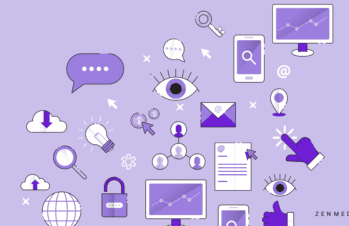Quantum marketing is a new way of looking at the B2B buyer journey and the digital marketing that B2B brands deliver to move those buyers along.
Why the “quantum”?
Because it’s grounded in the quantum model of particle physics—the discovery, dating to the 1920s, that rather than move in neat, predictable circles, the particles (electrons, specifically) in atoms actually move in an unpredictable, almost unintelligible way, even seeming to be in two different places at once.
This, it turns out, is an apt metaphor for how B2B buying and B2B marketing operate today. While we didn’t come up with the term (it’s a good one, LI!), we’ve been looking at these concepts for some time: the changing B2B buyer journey, the difficulty of mapping that journey, and the challenge of being in multiple places at the same time (hello, omnichannel).
Here’s what we’ve learned about the way B2B buyers behave, and our marketing has to change to reflect that.
The B2B buyer journey is ultimately unpredictable
B2B buyers move backward and forward along a winding, circuitous path. Sometimes they leave the path entirely, only to show up again at an entirely different spot.
Because the average size of buying groups has grown to 6-10 people, many of whom are Millennials and even Gen Z, all of whom have gathered information independently, it’s impossible for a brand to know or predict where everyone is at any given moment. Realistically, they’re likely all at different stages.
This is a new normal for B2B buying.
So it stands to reason that we also need a new normal for how we market to these buyers.
Omnichannel is a non-negotiable
Omnichannel marketing has been the rage since the widespread adoption of smartphones.
That’s when buyers were suddenly able to bring the web with them wherever they went. Instead of signing off when they left work, they could look up your brand any time they wanted, and from as many different devices and locations as they wanted.
Related post: How COVID-19 Is Changing Digital Marketing
That, of course, meant that If they started an inquiry or a purchase on one device, it needed to be seamless across all devices (this applied to phone and email too, not just website interactions). As time went on, omnichannel grew to mean more: it meant a seamless experience across devices, platforms, and communication channels, all with the goal of allowing the customer to interact with the brand in the way that they preferred.
Today, that’s all still an important part of omnichannel marketing—but in the context of quantum marketing, it takes on the additional meaning of reaching your customers where they are, at all times, at the same time.
Just like those electrons that are always moving unpredictably, and seem to be in two places at the same time, B2B buyers are too. They might research your brand, then get taken off the committee to handle a more time-sensitive project. Then in three years, they return to the buying table, but at another company. They remember you from earlier and pick right back up where they left off.
You can see how useful this model is when we think in realistic terms about how buyers behave in real life.
You don’t really know who your buyer is—and that’s ok
Buyer personas can be very useful when it comes to designing your digital marketing campaigns and targeting potential customers. We use them all the time with our clients—after all, if you don’t have at least some clear idea of whom you’re selling to, you’re going to miss a lot of opportunities.
However, in today’s B2B buying world, the buyer persona isn’t what it used to be.
Why?
Because of all the reasons stated above, plus one more important one. People switch jobs, careers, and industries much more often today than they used to, and the pandemic accelerated those movements.
Related post: The Ultimate Guide To Buyer Personas
On top of that, there are more freelancers and solopreneurs today than there used to be, as going out on one’s own becomes simpler and less dependent on capital. And while a solopreneur’s purchase certainly won’t be as large as that of an enterprise, these are still B2B customers who may very well need what you’re selling.
What all of this means is that people who may have had no reason to buy from you six months ago will need your product next week. The marketing rep who reads your blog now and then will become a CMO in four years—at which point she’ll remember your brand and recommend you as an option.
By bringing all these potential buyers into your fold of “customers to target,” you’re increasing your chances of getting through to not only the people who are currently looking to purchase, but also those who may become customers in the future.
If this feels like a less precise way of targeting buyers, you’re right. It is.
But it’s also something more brands should be doing. Uncertainty and change are two constants for all of us, marketers or not. Fighting that uncertainty by going after ever-more-accurate targeting will get some results, but it’s also a bit like banging your head against a brick wall.
As LinkedIn’s report says, it makes more sense to embrace an “always-on” model of digital marketing, where you’re targeting lots of people, broadly, all the time. It’s the same idea as trying to make your brand famous rather than trying to raise brand awareness. You want to be well-known in every industry, not just your specific niche.
We’ll be returning to this report and this topic regularly over the next several weeks. Got questions? We’d love to answer them!





